Mary Somerville
Mary Somerville (née Fairfax, formerly Greig; 26 December 1780 – 29 November 1872)[1] was a Scottish science writer and polymath. She studied mathematics and astronomy, and was nominated to be jointly the first female member of the Royal Astronomical Society at the same time as Caroline Herschel.
Mary Somerville | |
|---|---|
 Mary Somerville | |
| Born | Mary Fairfax 26 December 1780 |
| Died | 29 November 1872 (aged 91) |
| Resting place | English Cemetery, Naples, Italy |
| Nationality | Scottish |
| Citizenship | British |
| Awards | Patron's Medal (1869) |
| Scientific career | |
| Fields | Science writing Mathematics |
When John Stuart Mill, the philosopher and economist, organised a massive petition to Parliament to give women the right to vote, he had Somerville put her signature first on the petition.
When she died in 1872, The Morning Post declared in her obituary that "Whatever difficulty we might experience in the middle of the nineteenth century in choosing a king of science, there could be no question whatever as to the queen of science".[2][3]
Somerville College, a college of the University of Oxford, is named after her, reflecting the virtues of liberalism and academic success which the college wished to embody.[4] She is featured on the front of the Royal Bank of Scotland polymer £10 note launched in 2017, alongside a quote from her work The Connection of the Physical Sciences.[5]
Early life and education
Somerville was the daughter of Vice-Admiral Sir William George Fairfax,[6] scion of a distinguished family of Fairfaxes, and she was related to several prominent Scottish houses through her mother,[7] the admiral's second wife, Margaret Charters, daughter of Samuel Charters, a solicitor.[8]
%2C_by_William_Grimaldi_(1751-1830).jpg)
She was born at the manse of Jedburgh, in the Borders, which was the house of her maternal aunt, wife of Dr. Thomas Somerville (1741–1830) (author of My Own Life and Times).[7] Her childhood home was at Burntisland, Fife.[6] She was the second of four surviving children (three of her siblings had died in infancy). She was particularly close to her oldest brother Sam. The family lived in genteel poverty because her father's naval pay remained meagre as he rose through the ranks. Her mother supplemented the household's income by growing vegetables, maintaining an orchard and keeping cows for milk. Her mother taught her to read the Bible and Calvinist catechisms, and when not occupied with household chores Mary roamed among the birds and flowers in the garden.[9] In her autobiography Somerville recollects that after returning from sea her father said to her mother "This kind of life will never do, Mary must at least know how to write and keep accounts".[10] Thus the 10-year-old was sent for a year of tuition at an expensive boarding school in Musselburgh.[7] Somerville learned the first principles of writing, rudimentary French and English grammar.[11] Upon returning home, she:
...was no longer amused in the gardens, but wandered about the country. When the tide was out I spent hours on the sands, looking at the star-fish and sea-urchins, or watching the children digging for sand-eels, cockles, and the spouting razor-fish. I made collections of shells, such as were cast ashore, some so small that they appeared like white specks in patches of black sand. There was a small pier on the sands for shipping limestone brought from the coal mines inland. I was astonished to see the surface of these blocks of stone covered with beautiful impressions of what seemed to be leaves; how they got there I could not imagine, but I picked up the broken bits, and even large pieces, and brought them to my repository.[12]
Her shell collection was given to Somerville College, Oxford by her descendants.[13]
During bad weather she occupied herself with reading the books in her father's library, including Shakespeare, and fulfilling her "domestic duties". In later life she recollected "These occupied a great part of my time; besides, I had to shew my sampler, working the alphabet from A to Z, as well as the ten numbers, on canvas".[14] Her aunt Janet came to live with the family and reportedly said to her mother "I wonder you let Mary waste her time in reading, she never shews more than if she were a man". As a consequence Mary was sent to the village school to learn plain needlework. The youngster "was annoyed that my turn for reading was so much disapproved of, and thought it unjust that women should have been given a desire for knowledge if it were wrong to acquire it." The village school master came to the house on several evenings in the week to teach Mary. He taught her how to use the two small globes in the house. In her Personal Recollections Mary notes that in the village school the boys learned Latin, "but it was thought sufficient for the girls to be able to read the Bible; very few even learnt writing."[15]
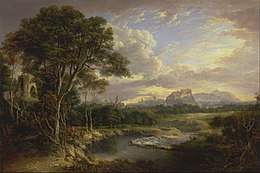
When Mary was 13 her mother sent her to writing school in Edinburgh during the winter months, where she improved her writing skills and studied the common rules of arithmetic.[16] Back in Burntisland she taught herself sufficient Latin to read the books in the home library.[17] While visiting her aunt in Jedburgh she met her uncle Dr Thomas Somerville and picked up the courage to tell him that she had been trying to learn Latin. Dr Somerville assured her that in ancient times many women had been very elegant scholars, and proceeded to teach her Latin by reading Virgil with her.[18][6] While visiting another uncle, William Charters, in Edinburgh, Mary was sent to Strange's dancing school, where she learned manners and how to curtsey.[19] She also accompanied her uncle and aunt on their visits to the Lyell family in Kinnordy; Charles Lyell would go on to become a celebrated geologist and a friend of Mary.[20]
With regard to the political upheaval of the time and the French Revolution she later wrote that her father was a Tory and that the "unjust and exaggerated abuse of the Liberal party made me a Liberal. From my earliest years my mind revolved against oppression and tyranny, and I resented the injustice of the world in denying all those privileges of education to my sex which were so lavishly bestowed on men."[21] Mary and her oldest brother Sam would refuse to take sugar in their tea, in protest against the institution of slavery.[22] Somerville asserted that her liberal religious and political opinions remained unchanged throughout her life, but that she was never a republican.[21]
While accompanying her uncle and aunt to Burntisland in the summer she had access to elementary books on algebra and geometry. She spent the summer learning to play the piano and learning Greek so that she could read Xenophon and Herodotus.[23] Back in Edinburgh she was allowed to attend the academy Alexander Nasmyth, which had opened for ladies. Nasmyth advised another student to study Euclid's Elements to gain a foundation in perspective, astronomy and mechanical science. Somerville spotted the opportunity, as she thought the book would help her understand Navigations by John Robertson.[24][6]
She continued in the traditional role of the daughter of a well-connected family, attending social events and maintaining a sweet and polite manner – she was nicknamed "the Rose of Jedburgh" among Edinburgh socialites.[25] Back in Burntisland a young tutor came to stay with the family to educate her younger brother Henry. Mr Craw was a Greek and Latin scholar, and Somerville asked him to purchase elementary books on algebra and geometry for her. He presented Somerville with Euclid's Elements and Algebra by John Bonnycastle.[26] Somerville would rise early to play the piano, painted during the day, and stayed up late to study Euclid and algebra.[27] When the family friend Lord Balmuto invited her to visit his family, Somerville first saw a laboratory.[28] She also spent some time with the Oswalds family in Dunnikeir. Somerville was impressed with their daughter Elizabeth Oswald, a bold horsewoman who became a Greek and Latin scholar and married Thomas Bruce, 7th Earl of Elgin.[29]
The winters were usually spent in Edinburgh, and under the care of Lady Burchan she made her first appearance at a ball, her first dancing partner being the Earl of Minto.[30] In the following autumn of 1797 her father was caught up in a mutiny while serving as flag-captain under Admiral Duncan on HMS Venerable, but the Battle of Camperdown against the Dutch fleet was won.[31] Her father was knighted and made Colonel of Marines.[32] Her eldest brother died at the age of 21 in Calcutta while serving in the East India Company's military service. The family had hoped that he would make a sufficient fortune in a few years to enable him to come home again.[33]
Marriage and studies
In 1804 she met her first husband, her distant cousin Lieutenant Samuel Greig, son of Admiral Samuel Greig,[8] when he came to pay a visit. He was commissioner of the Russian navy and Russian consul for Britain.[34] They married and had two children, one of whom, Woronzow Greig, would become a barrister and scientist.[35] They lived in London, but it was not a happy time for Somerville. Although she could study, her husband did not think much of women's capacity to pursue academic interests. Indeed, Greig "possessed in full the prejudice against learned women which was common at that time."[36] Somerville took lessons in French.[37] When her husband died in 1807, while she was still nursing their youngest child,[38] she returned home to Scotland.[25]
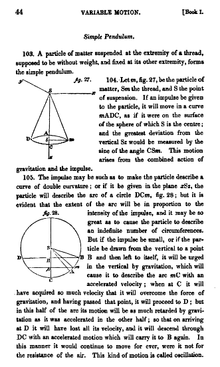
Back in Scotland she resumed her mathematical studies. By that time she had studied plane and spherical trigonometry, conic sections and James Ferguson's Astronomy. Now she first read Isaac Newton's Principia, which she continued to study.[39] Her inheritance from Greig gave her the freedom to pursue intellectual interests. John Playfair, professor of natural philosophy at University of Edinburgh, encouraged her studies, and through him she began a correspondence with William Wallace, with whom she discussed mathematical problems.[40] She started to solve mathematical problems posed in the mathematical journal of the Military College at Marlow and she eventually made a name for herself when solving a diophantine problem for which she was awarded a silver medal in 1811.[41][42] Somerville had five solutions published in Volumes 3 and 4 of the Mathematical Repository under the pseudonym 'A Lady'; two of these solutions demonstrated her early adoption of differential calculus, and therefore her contribution to the circulation and visibility of this mathematics in early 19th-century Britain.[43]
Wallace suggested that she should study the writings of the French mathematician Pierre-Simon Laplace, which summarised the theory of gravity and collected the mathematical results that had been established in the 50 years since Principia had been published. She said that studying Laplace's work gave her the confidence to persevere in her mathematical studies.[44] Somerville extended her studies into astronomy, chemistry, geography, microscopy, electricity and magnetism.[41] At the age of 33 she bought herself a library of scientific books. These included: Louis-Benjamin Francœur's Elements of Mechanics, Sylvestre François Lacroix' Algebra and Calculus Treatise, Jean-Baptiste Biot's Analytical Geometry and Astronomy, Siméon Denis Poisson's Treatise on Mechanics, Joseph-Louis Lagrange's Theory of Analytical Functions, Leonhard Euler's Elements of Algebra and Isoperimetrical Problems, Alexis Clairaut's Figure of the Earth, Gaspard Monge's Application of Analysis to Geometry, and François Callet's Logarithmus.[42]
In her Personal Recollections Somerville expressed the opinion that at the time mathematical science was at a low ebb in Britain, because reverence for Newton had prevented local scientists from adopting the calculus, while outside Britain astronomical and mechanical science had reached a high degree of perfection. In her opinion this deadlock was only broken when in 1816 Charles Babbage, John Herschel and George Peacock published a translation from French of the lectures of Lacroix, which was then the state-of-the-art calculus textbook.[39][45]
While staying with her family in Scotland, Somerville became acquainted with several leading intellectual lights, such as Henry Brougham.[46] In 1812 she married another cousin, Dr William Somerville (1771–1860), inspector of the Army Medical Board, who encouraged and greatly aided her in the study of the physical sciences.[47] Her husband was elected to the Royal Society and together they moved in the leading social circles of the day. As well as scientists, she was well known to leading writers and artists, for example J.M.W. Turner.[48] Her husband's family were neighbours of the writer Walter Scott. She wrote "I shall never forget the charm of this little society, especially the supper-parties at Abbotsford, when Scott was in the highest glee, telling amusing tales, ancient legends, ghost and witch stories."[49] In her second marriage Somerville had four children.
In 1819 her husband was appointed physician to Chelsea Hospital and the family moved to Hanover Square into a government house in Chelsea.[50] Somerville was a friend of Anne Isabella Milbanke, Baroness Wentworth, and was mathematics tutor to her daughter, Ada Lovelace. With Somerville, Ada attended the scientific gatherings where she met Charles Babbage. Somerville College owns a letter from Babbage to Somerville inviting her to view his 'Calculating Engine'.[51] Somerville visited Babbage frequently while he was "making his Calculating-machines".[52] Somerville and Lovelace maintained a close friendship and when Lovelace encountered difficulties with a mathematical calculation she would walk to Somerville's house and discuss the matter over a cup of tea.[50]
In 1823 the Somervilles' youngest daughter died after illness.[53] While living in Chelsea the Somervilles travelled across Europe on a number of occasions, leaving their children with their German governess. Among their travel companions was the jurist and politician Sir James Mackintosh. Before leaving London the Somervilles made contact with people they wanted to meet, and on their European tours they paid visits to numerous celebrated intellectuals.[54] The Somervilles also received frequent visitors; Maria Edgeworth would visit them when in England.[55]
Science practice and writing

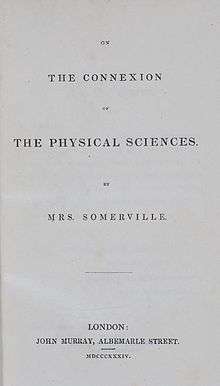
Somerville conducted experiments to explore the relationship between light and magnetism and she published her first paper, "The magnetic properties of the violet rays of the solar spectrum", in the Proceedings of the Royal Society in 1826.[41] Sir David Brewster, inventor of the kaleidoscope, wrote in 1829 that Mary Somerville was "certainly the most extraordinary woman in Europe - a mathematician of the very first rank with all the gentleness of a woman".[40]
Somerville was requested by Lord Brougham to translate for the Society for the Diffusion of Useful Knowledge the Mécanique Céleste of Pierre-Simon Laplace. Laplace had, in five exhaustive volumes, summed up the current state of gravitational mathematics and Mécanique Céleste was acclaimed as the greatest intellectual achievement since the Principia. Somerville produced not a translation, but an expanded version of the first two volumes. She wrote a standalone exposition of the mathematics behind the workings of the solar system,[56] of which she said "I translated Laplace's work from algebra into common language". It was published in 1831, under the title of The Mechanism of the Heavens. It made her at once famous. Mechanism was set as a textbook for undergraduates at University of Cambridge until the 1880s.[48]
After receiving a copy of Mechanism Joanna Baillie wrote to Somerville, "I feel myself greatly honoured by receiving such a mark of regard from one who has done more to remove the light estimation in which the capacity of women is too often held than all that has been accomplished by the whole Sisterhood of Poetical Damsels & novel-writing Authors."[57] The book was praised by George Peacock, Professor of the University of Cambridge, thus many of the 750 copies printed were bought in Cambridge. Reviews were favourable and Somerville received letters of congratulation from "many men of science".[58] She was elected honorary member of the Royal Irish Academy, of the Bristol Philosophical Institution and the Société de Physique et d'Histoire Naturelle de Genève in 1834.[59] The British Crown granted her a civil pension of £200 a year in recognition of her eminence in science and literature.[60]
Somerville was passionate about astronomy and believed it to be the most extensive example of the connection of the physical sciences in that it combined the sciences of number and quantity, of rest and motion.
In [astronomy] we perceive the operation of a force which is mixed up with everything that exists in the heavens or on earth; which pervades every atom, rules the motions of animate and inanimate beings, and is as sensible in the descent of a rain-drop as in the falls of Niagara; in the weight of the air, as in the periods of the moon.[61]
In Somerville's time the value of scientific publications depended on the currency of the information, therefore frequent editions had to be produced. Her subsequent books reflect the time she could free in her domestic life as her children became more independent but also the need to earn money, as the Somervilles had a number of financial crises that peaked in 1835. As a middle-class woman she publicly and plausibly maintained that she wrote only for pleasure. Privately she paid considerable attention to the profitability of her books.[62] Through personal connections she could secure John Murray as the publisher of her first book Mechanism, and he remained her publisher throughout her long career.[63] Murray later commented that despite him having made little profit he was very pleased to have had the honour of publishing the works of such an extraordinary person.[64] Her second book On the Connexion of the Physical Sciences sold 15,000 copies and established her reputation in elite science.[65]
She was among those who discussed a hypothetical planet perturbing Uranus. In the 6th edition of Connexion (1842) she wrote, "If after the lapse of years the tables formed from a combination of numerous observations should be still inadequate to represent the motions of Uranus, the discrepancies may reveal the existence, nay, even the mass and orbit of a body placed for ever beyond the sphere of vision".[66] Predictions were fulfilled in 1846 by the discovery of Neptune revolving at the distance of 3,000,000,000 miles from the sun. "The mass of Neptune, the size and position of his orbit in space, and his periodic time, were determined from his disturbing action on Uranus before the planet itself had been seen."[66] Connexion ran to 10 editions, more than 9,000 copies and was its publisher's most successful science book until The Origin of Species by Charles Darwin in 1859.[48] It was translated into German and Italian and went through various editions in the United States.[67]
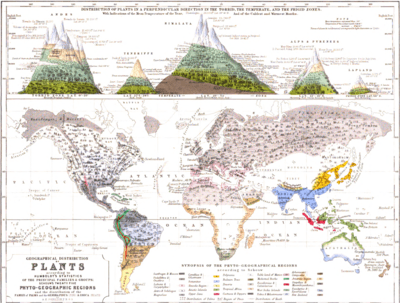
Her book Physical Geography was published in 1848 and was the first English textbook on the subject. It remained in use as textbook until the early 20th century.[40] At the time of publication it was financially very successful and brought her the Victoria Gold Medal of the Royal Geographical Society.[69] Somerville followed, as she said, "the noble example of Baron Humboldt, the patriarch of physical geography", and she took an extended view of geography that included the earth, its animal, "vegetable inhabitants", as well as "the past and present condition of man, the origin, manners, and languages of existing nations, and the monuments of those that have been".[70]

Physical Geography starts with describing the overall structure of planet earth, and a brief allusion to the location of the earth within the solar system. Subsequently, the book focuses on terrestrial topics, such as the most basic features of land and water, and formations such as mountains, volcanoes, oceans, rivers and lakes. Somerville goes on to discuss the elements that govern temperature, such as light, electricity, storms, the aurora and magnetism. Eventually the book turns to vegetation, birds and mammals, and their geographical distribution on the planet in the Arctic, Europe, Asia, Africa, America and the Antarctic. Somerville ends the book with a discussion of "the distribution, condition, and future prospects of the human race".<[71] Somerville emphasises the reciprocal dependencies in physical geography and the relationship between human beings and nature. In line with Victorian thinking, Somerville asserts the superiority of human beings, but maintains the interdependencies and interconnectedness of creation.[72] Physical Geography sold more copies than any of her other books and earned Humboldt's admiration. After receiving a copy of the book he wrote to Somerville: "You alone could provide your literature with an original cosmological work".[73]
Her fourth book Molecular and Microscopic Science was published in 1869 and had taken her 10 years to write. But she started to have doubts about her choice to devote herself to popularising science, instead of concentrating on mathematics alone.[74] Of the book she said: "In writing this book I made a great mistake, and repent it - Mathematics are the natural bent of my mind. If I had devoted myself exclusively to that study, I might probably have written something useful, as a new era had begun in that science."[75] Regardless, the book was another success. It gave an up-to-date description of the latest discoveries revealed through the microscope and was published in two volumes and three parts. In the first part Somerville explained the latest thinking on atoms and molecules, the second part covered plant life and the third part explored animal life. The book included 180 illustrations, which caused her publisher great expense.[76]
She was elected to the American Geographical and Statistical Society in 1857 and the Italian Geographical Society in 1870, and was made a member of the American Philosophical Society.[77]
Death
From 1833 onwards Somerville and her husband spent most of their time in Italy. Somerville maintained correspondence with a large number of leading scientists and remained engaged in current debates on facts and theories.[69]
In 1868, four years before her death aged 91, she was the first person to sign John Stuart Mill's unsuccessful petition for female suffrage.[78] In her autobiography Somerville wrote that "British laws are adverse to women". She detailed the obstacles she had faced in obtaining an education as a young girl, though she did not speculate on the nature of the problem. During her lifetime the agitation for establishing women's access to higher education had grown. In 1875 the astronomer Maria Mitchell was told by a college president that he "would hire a woman scientist if she was as good as Mary Somerville".[79]
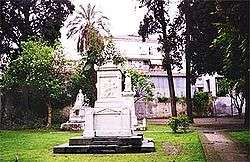
Somerville died at Naples on 29 November 1872, and was buried there in the English Cemetery.[80]
Legacy
In the year following Somerville's death, her autobiographical Personal Recollections was published, consisting of reminiscences written during her old age. Over 10,000 pieces are in the Somerville Collection of the Bodleian Library and Somerville College, Oxford.[69][81] The collection includes papers relating to her writing and published work, and correspondence with family members, numerous scientists and writers, and other figures in public life. Also included is substantial correspondence with the Byron and Lovelace families.
Somerville Square in Burntisland is named after her family and marks the site of their home.[8]
Somerville College, Oxford, was named after Somerville, as is Somerville House, Burntisland, where she lived for a time[40] and Somerville House, a high school for girls in Brisbane, Australia.[82] One of the Committee Rooms of the Scottish Parliament in Edinburgh has been named after her.[83]
Somerville Island (74°44′N 96°10′W), a small island in Barrow Strait, Nunavut, was named after her by Sir William Edward Parry in 1819.[84]
The Somerville Club was founded in 1878 in London, by 1887 it was re-established as the New Somerville Club and had disappeared by 1908.[85]
The vessel Mary Somerville was launched in 1835 at Liverpool. She traded with India for Taylor, Potter & Co., of Liverpool, and disappeared with the loss of all aboard in late 1852 or early 1853.
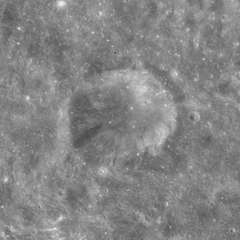
| Wikisource has original text related to this article: |
Mary Somerville featured in miniature in The English Bijou Almanack, 1837, with poetry by Letitia Elizabeth Landon.
5771 Somerville (1987 ST1) is a main-belt asteroid discovered on 21 September 1987 by E. Bowell at Lowell Observatory Flagstaff, Arizona, and named after her.[86] Somerville crater is a small lunar crater in the eastern part of the Moon. It lies to the east of the prominent crater Langrenus.[87] It is one of a handful of lunar craters named after women.
In February 2016 she was shortlisted, along with Scottish physicist James Clerk Maxwell and civil engineer Thomas Telford, in a public competition run by Royal Bank of Scotland to decide whose face should appear on the bank's new £10 notes, to be issued in 2017.[88] Later that month RBS announced that she had won the public vote, held on Facebook. The banknotes, bearing her image, were issued in the second half of 2017.[89]
On February 2, 2020, Google celebrated her with a Google Doodle.[90]
Children
From her first marriage she had a son, Woronzow Greig (1805-1865), named after Count Semyon Vorontsov, the Russian ambassador in London who had appointed Samuel Greig as his Consul General. Woronzow married Agnes Graham but all their children died at birth or in infancy.[8]
From her second marriage she had three daughters and one son: Margaret Farquhar Somerville (1813–1823; died in childhood), Thomas Somerville (1814–1815; died in infancy), Martha Charters Somerville (1815–1879) and Mary Charlotte Somerville (1817-1875). Her two surviving daughters spent most of their lives caring for Mary.[8]
Bibliography
- 1826 "On the magnetizing power of the more refrangible solar rays"
- 1831 Mechanism of the Heavens
- 1832 "A Preliminary Dissertation on the Mechanisms of the Heavens"
- 1834 On the Connection of the Physical Sciences
- 1848 Physical Geography
- 1869 Molecular and Microscopic Science
- 1874 Personal recollections, from early life to old age, of Mary Somerville
Notes
- "Mary Somerville | Biography, Writings, & Facts". Encyclopedia Britannica.
- Boreham, Ruth (8 March 2017). "Mary Somerville: Queen of Science". Dangerous Women. Retrieved 12 July 2018.
- "Mrs. Somerville (Obituary)". The Morning Post from London. 2 December 1872.
- Batson 2008, p. 23.
- "Royal Bank of Scotland - £10 Polymer". www.scotbanks.org.uk. Archived from the original on 18 April 2019. Retrieved 19 August 2019.
- Mary T Brück (1996). "Mary Somerville, mathematician and astronomer of underused talents". Journal of the British Astronomical Association. 206 (4): 201. Bibcode:1996JBAA..106..201B.
- Somerville, Mary Fairfax Greig. Dictionary of Scientific Biography. 11 & 12. New York: Charles Scribner's Sons. 1981. pp. 521–522.
- "Mary Somerville's Family". Burntisland Heritage Trust. Retrieved 26 November 2018.
- Arianrhod, Robyn (2012). Seduced by Logic: Émilie Du Châtelet, Mary Somerville and the Newtonian Revolution. Oxford University Press. p. 163. ISBN 9780199931613.CS1 maint: ref=harv (link)
- Somerville, Martha (1874). Personal Recollections, from Early Life to Old Age, of Mary Somerville: With Selections from Her Correspondence. Roberts Brothers, digitised 2007, original in Harvard University. p. 21.CS1 maint: ref=harv (link)
- Somerville (1874), p. 22.
- Somerville (1874), p. 25.
- Emerson, L. Somerville 140, 1879-2019, A Celebration of Somerville College, Oxford, in 140 Objects. Scala. p. 26.
- Somerville (1874), p. 27.
- Somerville (1874), p. 28.
- Somerville (1874), p. 35.
- Somerville (1874), p. 36.
- Somerville (1874), p. 37.
- Somerville (1874), p. 41.
- Somerville (1874), pp. 43–44.
- Somerville (1874), pp. 44–46.
- Arianrhod (2012), p. 165.
- Somerville (1874), pp. 47–48.
- Somerville (1874), p. 49.
- Somerville, Mary Fairfax Greig. Dictionary of Scientific Biography. 11 & 12. New York: Charles Scribner's Sons. 2014. p. 522. Bibcode:2014bea..book.2030M.
- Somerville (1874), p. 53.
- Somerville (1874), p. 45.
- Somerville (1874), p. 55.
- Somerville (1874), p. 56.
- Somerville (1874), p. 62.
- Somerville (1874), p. 68.
- Somerville (1874), p. 69.
- Somerville (1874), p. 70.
- Somerville (1874), p. 74.
- Appleby, J.H (22 January 1999). "Woronzow Greig (1805–1865), F.R.S., and his scientific interests" (PDF). Notes and Records of the Royal Society. 53 (1): 95–106. doi:10.1098/rsnr.1999.0065. Retrieved 19 August 2007.
- Somerville (1874), p. 3.
- Somerville (1874), p. 75.
- Somerville (1874), p. 77.
- Somerville (1874), p. 78.
- O'Connor, John J.; Robertson, Edmund F., "Mary Fairfax Greig Somerville", MacTutor History of Mathematics archive, University of St Andrews.
- John Holmes; Sharon Ruston (2017). The Routledge Research Companion to Nineteenth-Century British Literature and Science. Routledge. p. 59. ISBN 9781317042334.
- Somerville (1874), p. 79.
- Stenhouse, Brigitte (December 2019). "Mary Somerville's early contributions to the circulation of differential calculus". Historia Mathematica: S0315086019300771. doi:10.1016/j.hm.2019.12.001.
- Arianrhod (2012), p. 173.
- Constructing a Bridge: An Exploration of Engineering Culture, Design, and Research in Nineteenth-century France and America. MIT Press. 1997. p. 110. ISBN 978-0-262-11217-8. Retrieved 26 April 2013.
- Somerville (1874), p. 81.
- Somerville (1874).
- Baraniuk, Chris (1 July 2017). "The queen of science". New Scientist (3132): 40–41.
- Somerville (1874), p. 96.
- Elisabetta Strickland (2016). The Ascent of Mary Somerville in 19th Century Society. Springer. p. 16. ISBN 9783319491936.
- "Somerville and Mathematics" (PDF). Mathematics Institute, University of Oxford. Retrieved 17 February 2016.
- Somerville (1874), p. 141.
- Somerville (1874), p. 153.
- Elisabetta Strickland (2016). The Ascent of Mary Somerville in 19th Century Society. Springer. pp. 16–17. ISBN 9783319491936.
- Somerville (1874), p. 65.
- Arianrhod (2012), p. 3.
- Baillie, Joanna (2010). McLean, Thomas (ed.). Further Letters of Joanna Baillie. Madison, NJ: Fairleigh Dickinson Univ Press. p. 144. ISBN 978-0-8386-4149-1.
- Somerville (1874), p. 173.
- Somerville (1874), p. 176.
- Somerville (1874), p. 177.
- "Full text of "On the connection of the physical sciences"". archive.org. Retrieved 17 February 2016.
- Neeley, Kathryn A.; Somerville, Mary (2001). Mary Somerville: Science, Illumination, and the Female Mind. Cambridge University Press. pp. 124. ISBN 9780521626729.CS1 maint: ref=harv (link)
- Neeley & Somerville (2001), p. 78.
- Neeley & Somerville (2001), p. 80.
- Neeley & Somerville (2001), p. 87.
- Somerville (1874), p. 290.
- Somerville (1874), p. 203.
- Martha Somerville (1851). Physical Geography. J. Murray, digitised 2006, original held by University of Michigan. pp. vi.
- Catharine M. C. Haines (2001). International Women in Science: A Biographical Dictionary to 1950. ABC-CLIO. pp. 293. ISBN 9781576070901.
- Neeley & Somerville (2001), p. 133.
- Neeley & Somerville (2001), p. 134.
- Neeley & Somerville (2001), p. 137.
- Neeley & Somerville (2001), pp. 132 & 230.
- Elisabetta Strickland (2016). The Ascent of Mary Somerville in 19th Century Society. Springer. p. 65. ISBN 9783319491936.
- Somerville (1874), p. 338.
- Elisabetta Strickland (2016). The Ascent of Mary Somerville in 19th Century Society. Springer. pp. 65–66. ISBN 9783319491936.
- Oughton, M. (1978), Freeman, T. W; Oughton, M.; Pinchemel, P. (eds.), "Mary Somerville, 1780–1872", Geographers: biobibliographical studies, London and New York: Mansell, 2, pp. 109–11
- Arianrhod, Robyn (29 November 2012). "What sort of science do we want?". OUPblog. Oxford University Press. Retrieved 29 November 2012.
- Neeley & Somerville (2001), pp. 118 & 215.
- Giancarlo Alisio, Il Cimitero degli Inglesi, Naples, 1993, ISBN 88-435-4520-5
- "Mary Somerville Papers". www.bodley.ox.ac.uk. Retrieved 17 February 2016.
- "Somerville House". Schools. Presbyterian and Methodist Schools Association. Archived from the original on 16 February 2008. Retrieved 16 March 2008.
- "Committee Rooms" (PDF). Scottish Parliament. Retrieved 26 November 2018.
- Patterson, Elizabeth Chambers (1983). Mary Somerville and the Cultivation of Science, 1815–1840. Springer. pp. 57–58. doi:10.1007/978-94-009-6839-4. ISBN 978-94-009-6841-7.(subscription required)
- Crawford, Elizabeth (2003). The Women's Suffrage Movement: A Reference Guide 1866-1928. Routledge. p. 128. ISBN 978-1-135-43402-1.
- Schmadel, Lutz D. (2007). Dictionary of Minor Planet Names – (5771) Somerville. Springer Berlin Heidelberg. p. 488. doi:10.1007/978-3-540-29925-7_5435. ISBN 978-3-540-00238-3.
- "Planetary Names: Crater, craters: Somerville on Moon". Gazetteer of Planetary Nomenclature. International Astronomical Union. Retrieved 26 November 2018.
- "Royal Bank of Scotland announces shortlist to appear on new £10 note". Royal Bank of Scotland. 1 February 2016. Retrieved 13 March 2016.
- The Scotsman dated 11 August 2017.
- "Celebrating Mary Somerville". Google. 2 February 2020.
References
- Somerville, Martha. Personal Recollections, From Early Life to Old Age, of Mary Somerville. Boston: Roberts Brothers, 1874. (written by her daughter) Reprinted by AMS Press (January 1996), ISBN 0-404-56837-8
- Neeley, Kathryn A. Mary Somerville: Science, Illumination, and the Female Mind, Cambridge & New York: Cambridge University Press, 2001.
- Fara, Patricia (September 2008). "Mary Somerville: a scientist and her ship". Endeavour. England. 32 (3): 83–5. doi:10.1016/j.endeavour.2008.05.003. PMID 18597849.
- Batson, Judy G. (2008). Her Oxford. Nashville: Vanderbilt University Press. ISBN 978-0-8265-1610-7.
External links
| Wikimedia Commons has media related to Mary Somerville. |
| Wikisource has original works written by or about: Mary Somerville |
- "Mary Fairfax Somerville", Biographies of Women Mathematicians, Agnes Scott College
- Mary Somerville, an article by Maria Mitchell, Atlantic Monthly 5 (May 1860), 568–571.
- Bibliography from the Astronomical Society of the Pacific
- "Archival material relating to Mary Somerville". UK National Archives.

- Catalogue of correspondence and papers of Mary Somerville and of the Somerville and related families, c.1700–1972, held at the Bodleian Library, University of Oxford
- Works by Mary Somerville at Project Gutenberg
- Works by or about Mary Somerville at Internet Archive
.jpg)